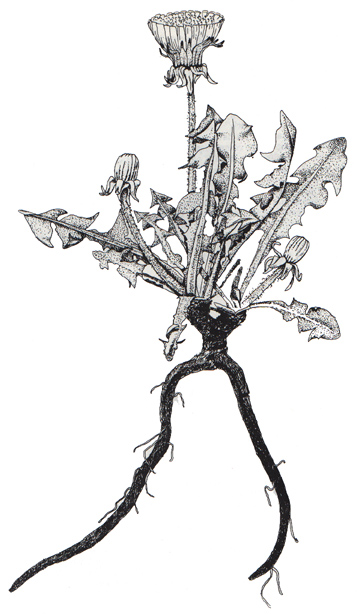
Dandelion
Taraxacum officinale
(Compositae)
Description:
This ubiquitous and cosmopolitan lawn and garden weed is
also one of the most ancient remedies in the herbalist's repertoire, as the
species name suggests. The common name, dandelion, stems from the French "dent
de lion" or lion's tooth.
Its sunny yellow flowers that turn into white balls of airborne seeds are familiar to everyone I have encountered, although not everyone has dug the plant up to observe the vertical taproot furnished with numerous short, thickened rootlets. The leaves all attach at one point, the place where the stem and the taproot meet at the surface of the soil; they form a circle or basal rosette. Leaves are variously lobed and toothed and may be less than 2 inches to almost 2 feet (5 to 50 cm.) long, depending on habitat.

Method of Collection:
Early June is the best time to harvest dandelion
greens. I dig the whole plant from the garden with a shovel; it is easiest if
the soil is soft from recent rain. Knocking the extra dirt from the roots, or
picking away clods of dirt with fingers is easy enough, but if you want to use
the greens and edible buds they are rather difficult to clean. Try to be careful
not to get dirt on them. A strategy I discovered to minimize the spreading of
dirt onto greens and buds was to collect small quantities at one time, process
them, and then go back to dig for more. In a huge pile of uncleaned plants the
dirt would inevitably be shaken from the roots onto the leaves.
The final cleaning of the roots works best with a dry brush, about 9 inches long, with big bristles. You do not want to use water, because wetting the roots would slow down the drying. Hitting the root with the tips of the stiff bristles is a good way to get it just as clean, and also removes the slender rootlets that protrude from the taproot. Slice the roots into 1/2-inch (1 centimeter) pieces. I have found it much easier to dry the dandelion roots if they are chopped; if I do not chop them into chunks when they are fresh it is almost impossible to do it later when they are hard and dry. The chopped roots dry in three days if they are spread out on a net, screen or drying rack.
Sun-drying does not damage roots as much as it damages leaves or stems. A warm, dark, well-ventilated place in a house or shed is all right. The warming oven of a woodstove is not too hot; in fact, slight roasting improves the sweet taste of dandelion roots. Some herb collectors are now using microwave ovens to dry their harvest.
The number of species is large, with many groups that are only recognized by specialists, but the one called Taraxacum officinale is the most widespread. Originally from Europe, it was introduced into South Africa, South America, North Zealand, Australia, India, and all of North America except the tundra barrens, although another species grows in the high Arctic tundra. Like most introduced weeds it is common in waste places, roadsides, and gardens.
Medicinal uses:
Dandelion has been considered a mild detergent, aperient, and diuretic.
The Latin name, officinale, indicates that dandelion was the official remedy for a number of ailments. It was an ingredient in many of the patent remedies of the snake-oil peddler days. To quote Millspaugh, "Taraxacum has been used in medicine from ancient times; it is one of those drugs, overrated, derogated, extirpated, and reinstated time and again by writers upon pharmacology, from Theophrastus to the present day."
Dandelion has been recommended in hepatic obstruction, and as a general liver and kidney stimulant. Since liver and kidney disorders manifest themselves in numerous ways, the dandelion root juice and extracts have been popular as a general tonic over the entire world. The plant's slightly bitter taste seems medicinal to many people.
Copyright © 1987 by Eleanor G. Viereck